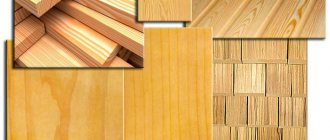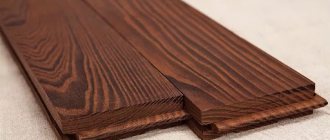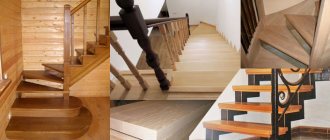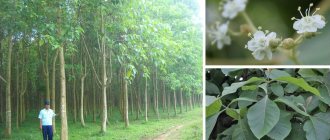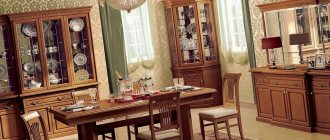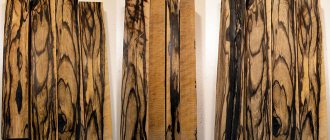Oak tree - properties and description
The tree itself is a truly powerful and majestic plant. On average, the duration of its development varies between 300-400 years, and there are individual specimens up to 1500 years old. The tree can reach a height of 30-50 m, growing widely in the crown, while having a powerful and strong trunk with a diameter of up to 2 m.
The characteristics, appearance, and properties of oak wood may differ depending on the region of growth, but there are qualities common to all varieties that remain unchanged. This is what attracts home craftsmen and specialists from various industrial sectors; oak wood is used everywhere in various forms.
As for the differences, the following interesting facts can be noted:
- oak wood growing near water bodies has a pleasant pink tint, large layers are clearly visible, and with good elasticity, this material has a very large weight;
- the light yellow tint of the core is characteristic of those trees that grow in wooded areas; the hardness of such material is slightly lower.
Oak - a tree for centuries
Oak (Quercus) is a genus of perennial plants in the Beech family, with about 600 species. But the most common oaks are common oak, European oak, English oak, sessile oak, Mongolian oak and cork oak.
Features of growth
The height of an individual tree reaches up to 40 m. It has a tent-shaped, powerful crown. These are long-lived trees. The average age is about 400 years. They are characterized by very slow growth. For example, until the age of 80, oak trees grow more in height, and then they begin to produce most of their growth in thickness.
After 200 years, they increase only in circumference and can reach up to 10-13 m in diameter.
The fruits are acorns with yellow-brown stripes. They are immersed in a cup-shaped plus. They ripen in September-October, but begin to bear fruit only from 40-60 years of age. The frequency of the most generous acorn harvests is 4-8 years.
Distribution and properties of oak
Single trees and oak forests are distributed mainly in temperate regions of the Northern Hemisphere. There are absolutely none in Australia and central Africa.
And oak was brought to South American territory artificially. Among oak trees there are valuable woody, tannid-bearing, medicinal and ornamental plants, some of which were widely used as food in the past.
In folk medicine, not only leaves and fruits are used, but also oak bark. Currently, they are used not only for medicinal properties, but also as a building material, as well as in landscape design compositions.
Back in Soviet times, archaeological scientists, during excavations of ancient settlements of the Trypillian culture, found evidence that the people of that time ground acorns into flour. According to Soviet scientists, bread was baked from it. Today it is known that a drink called “acorn coffee” can also be made from oak acorn flour.
Application of oak wood
The properties and uses of oak wood differ depending on exactly when the trees were cut down:
- Summer wood is excellent for construction and has excellent resistance to moisture, even being used in the construction of underwater structures. This wood is also suitable for the production of various souvenirs and crafts.
- Winter is an option for furniture, construction, and parquet production.
The choice of a suitable material for specific purposes can be made by visually assessing the appearance of oak wood:
- if there are wide annual rings, then this is an excellent choice for construction;
- if the annual rings are narrow, then this is the best material if you plan to make furniture, turned items, souvenirs, and sculptures.
Physical and mechanical properties of wood
The values of the physical and mechanical parameters of wood in most cases become the determining factor in the selection of building materials for the construction of buildings and architectural structures (log houses, stairs, rafter systems, floors) and the production of various products (windows, doors, floors, furniture, etc.) . Let's take a closer look at these characteristics for lumber in comparison with other building materials used.
Physical properties of lumber
Physical properties include macrostructure characteristics, appearance, density, sound and thermal conductivity, and indicators related to humidity (cracking, swelling, shrinkage, warping).
Appearance - determined by macrostructure, color, gloss and texture.
- Color - wood receives due to the presence in it of varying concentrations of tannins, resins and dyes; it may have uncharacteristic shades due to infection with fungal diseases. A very important characteristic that plays a decisive role in the selection of design solutions for the interior and exterior decoration of buildings, for example, when choosing imitation timber and the type of wood from which it is made. The manufacture of furniture, doors, windows and other carpentry is also based on this characteristic.
- Texture is the name given to the pattern visible on cuts in wood. Depends on the width and location of the annual layers, large internal vessels and medullary rays. Most tangentially cut lumber has a more beautiful texture; coniferous tree species do not have high characteristics in terms of texture beauty.
- Gloss is the property of reflecting the incident light flux, determined by the density and characteristics of the macrostructure of lumber. You can artificially increase the shine of lumber by sanding and varnishing.
- Humidity is measured by the formula W = (m–m0) / m0 × 100, where m is the mass of the sample being tested, m0 is the mass of the absolutely dry sample. The method is very accurate, but very time consuming and requires special instruments and devices. Currently, devices have been developed that almost instantly determine the moisture content of wood by changing the electrical conductivity readings depending on the amount of water.
Moisture content of lumber
The moisture content of lumber is associated with the phenomena of shrinkage, swelling, cracking and warping. Humidity is a very important indicator, which greatly influences the stability of the geometric shapes of various structures and lumber products. It should be noted as significant - an indicator of wood resistance to high humidity. Coniferous species have excellent characteristics according to these values. Reducing the moisture content of lumber will lead to an increase in positive characteristics, namely, a decrease in thermal conductivity and sound permeability, and will also increase the service life of the product or building. It is possible to change the humidity indicator, reducing the moisture content, in different ways, from technologically advanced on an industrial scale to traditional at home. For example, using atmospheric drying, described in detail in GOST 3808.1-80. You can learn in detail about drying methods based on state standards and norms, as well as taking into account practical experience, in the article - atmospheric drying technology.
Among other species, aspen is especially noteworthy. It is superior to coniferous wood in its resistance to high humidity and serves as an ideal material during the construction of baths, steam rooms and other architectural elements operating in conditions of high humidity or direct contact with water.
Coefficients of volumetric shrinkage (Ku) and swelling (Kp) of lumber towards the fibers
| Type of lumber | Volumetric | Radially | Tangentially | |||
| Ku | Kr | Ku | Kr | Ku | Kr | |
| Larch | 0.52 | 0.61 | 0.19 | 0.20 | 0.35 | 0.39 |
| Pine | 0.44 | 0.51 | 0.17 | 0.18 | 0.28 | 0.31 |
| Cedar | 0.37 | 0.42 | 0.12 | 0.12 | 0.26 | 0.28 |
| Aspen | 0.41 | 0.47 | 0.14 | 0.15 | 0.28 | 0.30 |
* The lower the coefficients, the better the wood, the better quality the products made from it will be.
- Shrinkage is a decrease in the linear parameters of lumber due to loss of moisture.
- Warping. Changes in the geometric dimensions and shape of lumber under the influence of humidity indicators are called warping. Can be longitudinal, transverse, arcuate, screw, etc.
- Density. Depends on the type of lumber and humidity levels. Many mechanical indicators of wood strength depend on density.
- Sound conductivity. The property of materials to conduct sound waves without losing their power. Sound in wood travels best in the direction of the grain, much worse in the radial direction. Sound conductivity indicators depend on the density and structural features of lumber. In construction, the absorption coefficient of sound waves is used; this indicator plays a significant role in creating comfortable conditions for people to stay indoors.
Warping of lumber
Average densities of lumber, kg/m3
| Wood type | Density of absolutely dry lumber | Density at 12% humidity |
| Larch | 630 | 660 |
| Spruce | 420 | 445 |
| Cedar | 410 | 435 |
| Scots pine | 470 | 500 |
| Aspen | 470 | 495 |
| Siberian fir | 350 | 375 |
We suggest that you familiarize yourself with the table of soundproofing properties of wood and products made from it (lumber), where you can compare them with other building materials.
Indicators of sound absorption coefficients of various building materials
| Name | Sound absorption coefficient at 1000 Hz vibrations |
| Tree | 0.06–0.1 |
| Brick | 0.032 |
| Concrete | 0.015 |
| Mineral wool | 0.45–0.95 |
- Thermal conductivity. One of the most important characteristics of all building materials. Thermal conductivity is directly related to waterproofing and vapor barrier characteristics. In terms of thermal conductivity, lumber occupies one of the leading places among all types of building materials. Vapor permeability and air permeability are the property of wood to exchange air between internal and external surfaces. Lumber can “breathe”, which has a beneficial effect on the indoor microclimate.
Comparative table of thermal conductivity and vapor permeability
| Material | Thermal conductivity, W/m2×С° | Vapor permeability, Mg/(m2×h×Pa) |
| Reinforced concrete | 1.69 | 0.03 |
| Concrete | 1.51 | 0.03 |
| Brick, silicate | 0.70 | 0.11 |
| Ceramic hollow brick | 0.35 | 0.17 |
| Foam concrete | 0.29 | 0.11 |
| Red clay brick | 0.56 | 0.11 |
| Expanded clay concrete | 0.66 | 0.09 |
| Pine, spruce along the grain | 0.18 | 0.32 |
| Pine, spruce across the grain | 0.09 | 0.06 |
| Chipboard, OSB | 0.15 | 0.12 |
| Plywood | 0.12 | 0.02 |
Mechanical properties of lumber
The ability to withstand static and dynamic loads without changing the original shape or destroying integrity is an indicator of the mechanical strength of wood. The higher the mechanical characteristics, the higher the quality of the lumber.
- Strength is the property of lumber to resist destruction. The main types of acting forces are: compression, long-term static bending, tension and shear. Strength indicators largely depend on the direction of action of forces in relation to the fibers. Lumber can withstand only 1/20 of the forces across the grain that it can withstand along the grain. Coniferous woods occupy an intermediate place in terms of strength characteristics among all types of wood. Birch has good performance; it can be used to make loaded integral structures or individual structural elements: dowels, furniture parts, wear-resistant elements of individual architectural structures and carpentry. Indicators of physical strength are measured in specialized laboratories taking into account current state regulations.
Determination of bending strength
Determination of compressive strength
Determination of tensile strength
Determination of shear strength
The compressive strength across the grain of wood is eight times lower than the strength along the grain. Softwood lumber has the property of compacting to 1/3 of the initial height parameters without visible destruction. Tests can be carried out in various directions with respect to the location of the fibers, including tangential. Coniferous trees, unlike deciduous trees, have higher performance in the tangential direction. You can find out more about the types of cuts here.
- Hardness. The property of lumber to resist the penetration of solid objects. The end hardness is always higher than the lateral hardness. In terms of hardness, wood is inferior to most building materials.
- Impact strength. The ability to absorb dynamic loads without visible destruction or disruption of surface linearity. Lumber has relatively high impact strength values.
- Splitting. In the radial plane, the resistance to splitting of conifers is significantly less than in other directions.
Maximum tensile strength, MPa
| Wood type | Static bend | Compression along the fibers | Splitting along the fibers | ||
| Radial | Tangential | ||||
| Scots pine | 86/50 | 49/21 | 7,5/4,3 | 7,3/4,5 | |
| Larch | 112/62 | 65/26 | 9,9/6,3 | 9,4/5,8 | |
| Fir | 69/41 | 39/18 | 6,4/4,5 | 6,5/4,2 | |
| Spruce | 80/44 | 45/20 | 6,9/4,1 | 6,8/4,4 | |
| Birch | 110/60 | 55/23 | 11/5,9 | 11,2/5,9 | |
| Aspen | 78/46 | 73/19 | 6,3/3,6 | 8,6/5 | |
- Ability to hold metal hardware. Smooth nails partially cut and partially push the fibers apart and are fixed by friction. Wood screws catch on the grain. The pull-out resistance of screws is twice that of nails.
- Ability to bend. An important property during the manufacture of various furniture or decorative architectural structures. Conifers bend poorly in a dry state; before bending, they must be soaked, followed by stress drying to the humidity values required by the production technology.
- Wear resistance is the ability to withstand long-term friction loads on the surface zones of lumber. An important characteristic that influences the service life of wood products and structures. Depends on the direction of the cut and the natural properties of the wood. The end surfaces have the highest performance, with tangential cutting in second place. Dry wood wears out much more slowly than wet wood.
When designing loaded wooden structures, it is not the calculated laboratory indicators of mechanical strength that are taken, but a special correction factor is used. It takes into account the possible presence of natural wood defects, diseases, and putrefactive processes. You can study the description of wood defects, their classification and impact on the quality of lumber in the material - classification of wood defects or wood defects.
In addition, the values are adjusted taking into account the grade of lumber. Methods and criteria for sorting lumber by grade are described in the article - grades of edged boards and timber. In practice, all indicators of mechanical strength are reduced by at least two times; only these values are taken as initial data during engineering calculations of various structures of buildings and structures.
Technological advantages of softwood lumber
- Environmental characteristics. In terms of safety for people, only red brick can compare with lumber. All other building materials existing today emit harmful chemical compounds into the air in varying quantities. This is especially true for laminated materials (plywood, OSB, MDF and chipboard), and laminated lumber. The amount of harmful substances that is considered safe is determined by government agencies; in each country it has its own values. Safety indicators are not objective, but depend on existing legislation.
- Performance characteristics. These include heat loss, soundproofing, load-bearing performance and durability of use. Based on the totality of these indicators, wood is considered the best material in construction. In terms of heat-saving properties or energy efficiency, 20 cm thick softwood edged timber (pine or spruce) replaces a 60 cm thick brick wall and a 1.2 meter thick concrete wall. Indicators for sound permeability are located in the same ratios. The ratio of strength to thermal conductivity of lumber is in the first place; they can withstand the load of multi-story buildings. The duration of operation largely depends on the conditions; some ancient buildings still stand. To increase resistance to rotting and open fire, special impregnations are used - the initial characteristics are significantly improved.
- Design characteristics. The beauty of the natural texture of wood is unparalleled; no artificial material can compare with the natural pattern.
- Manufacturability of processing. Wood can be easily processed with all machines, electric and hand carpentry tools. It holds hardware perfectly; to fix individual elements of products, there is no need to drill additional holes for dowels. The low specific gravity facilitates the process of transportation and storage of lumber.
- Price. There are cheaper materials, but you shouldn’t rely on price alone. Experienced builders advise paying attention to the ratio of price to all other characteristics. Only in this way can significant savings be achieved not only on the construction of a house, but also on its maintenance. A comprehensive assessment of the characteristics of lumber puts them in first place among all construction, finishing and decorating materials used today.
- Wide price range. Depending on the grade and type of wood, lumber prices may vary several times. This allows you to make the best choice for each individual case, select materials taking into account the specific location of their use, possible loads and design requirements.
Conclusion
Wood products are an excellent choice both for building a house and for finishing it. It is important to know that for the safe and long-term operation of houses and premises made of wood, it is necessary to take into account building codes and regulations related to the processing of wooden structures, installation of electrical systems, and heating devices. More details in the following materials...
Processing technologies
What characteristics oak wood will ultimately have is influenced by the processing technology used, because, for example, the properties of bog oak and bleached or other options will differ.
Despite the fact that today special chambers are widely used to speed up the drying process of wood, this technology is not recommended for use with oak. Due to the characteristics of the structure and density, hardness of oak, cracking may occur if moisture is lost too quickly. With traditional drying, this takes about 3 years.
Staining - using this technology, oak wood is given a decorative appearance. The principle of processing the material is that it is soaked in water for several years. As a result, the wood acquires an interesting rich purple hue, a silky texture, and its hardness increases.
Brushing is another oak processing technology in which some of the soft wood fibers are mechanically removed. As a result, the surface has a clearly defined structure of annual rings and pores; they are often painted in different colors.
The influence of natural conditions on the properties of wood
English oak grows on nutritious soils of the European part of Russia. This is one of the most durable species with positive performance properties, which has made it a valuable material used for house construction. The wood has a pronounced texture (a large number of heart-shaped rays) and a noble color - the core is brown with a green tint.
It is elastic, dense (690 kg/m3), strong, retains its quality when exposed to air, even after being underground or under water for a long time. When processed, it cracks moderately, chips easily, bends without effort, and is well impregnated with modern protective compounds. She is not afraid of fungus.
Bog oak, which has lain in water for a long time, has high decorative significance. Its wood is dark, almost black. After undergoing the etching procedure, the structure becomes voluminous and silky. This is a favorite material when decorating antique-style rooms. The panels are appropriate in living rooms made in a classic style.
Types of oak and their use
Oak trees grow in various climatic conditions, the most popular in various industries are the following types:
- bleached is the best option for parquet production;
- stained - well suited for making furniture;
- red - furniture, parquet, and various interior items are made from this material; the unique property of this oak wood is its color and high resistance to impact;
- cork - it is used to make not only everyday items, but also floor and wall coverings, which stand out on the market for their environmental friendliness;
- black - used in the manufacture of furniture, has maximum strength indicators;
- Arden - belongs to the class of “elite” wood, suitable for the production of furniture and parquet.
Wood parts
The purpose of the root is to absorb moisture from the soil with minerals dissolved in it and transfer it through the trunk to the crown; in addition, it holds the tree in an upright position.
The purpose of the trunk is to carry moisture absorbed by the roots with mineral salts dissolved in it up into the crown; drain nutrients down; maintain reserves of nutrients necessary in the spring for the development of leaves; serve as a support for the crown.
Fig. 1 Cross-section (end) of an oak trunk: 1—bark, 2—sapwood; 3 - core; 4 - core.
The lower part of the tree trunk is called the butt, the upper part is called the apex. At the junction of the trunk and the root, there is a knot - a sharp increase in the diameter of the tree trunk over a short length. In the crown, the leaves produce organic substances - carbohydrates necessary for the nutrition and growth of the tree. The main mass of wood comes from the trunk, which makes up 70 to 90% of the tree’s volume and is used as a building material.
Our country ranks first in the world in timber reserves. Of the 3 billion hectares of forest area covering the earth's surface, Russia accounts for more than one billion hectares. Coniferous forest, the most important for construction and industry, occupies more than half of all coniferous forests in the temperate zone of the globe. Timber reserves are especially large in the north of Russia, the Urals, and Western Siberia.
The lightness and high strength of wood (tensile and compressive along the fibers), low thermal conductivity, and ease of processing contribute to the widespread use of this material and, in particular, in the construction of both capital and auxiliary and temporary structures. Along with this, wood also has significant disadvantages, namely:
- heterogeneity of structure, and consequently, unequal properties in different directions (low tensile strength across the fibers and shear strength);
- the ability to change its humidity in the air and, accordingly, its size, shape and strength;
- the ability to quickly collapse from rotting under unfavorable storage and operating conditions;
- easy flammability.
However, these wood defects can be largely eliminated by appropriate processing.
Design and characteristics of oak furniture
Any oak furniture in the interior immediately attracts attention with its beauty and solidity. In addition, the material ensures the practical and functional operation of objects, regardless of their intended purpose. In terms of long-term use and preservation of original characteristics, oak furniture is difficult to find analogues. It is reliable, will easily last for more than 100 years, and always remains relevant, despite changing trends in interior design.
The wood texture with clearly defined “veins” gives oak furniture a special elegance and sophistication. You can choose any color according to your preference from a wide range of options from white to brown. This is an ideal option for both a home kitchen or bedroom, living room, and for the office of the head of a reputable company.
How to make an original children's table from oak: step-by-step instructions
If you have oak scraps, you can make an original children's table.
Table 3. Instructions for making a table
| Illustration | Description |
Step 1 | From the available oak board scraps, you need to select 4 elements of the required size. |
Step 2 | Two oak boards 90 cm long are cut and jointed to make a tabletop. |
Step 3 | The boards are glued together, the required tabletop shape measuring 50 x 80 cm is cut out, and the surface is sanded. The height of the finished product should be 50 cm. |
Step 4 | Grind the trimmings. |
Step 5 | The parts are tinted with stain. |
Step 6 | Decorative butterflies are installed and the ends of the tabletop are tinted. |
Step 7 | The trimmings are fixed with dowels and glue. |
Step 8 | Pre-made and stained legs made from oak round timber are fixed to dowels and glue. |
Step 9 | The product is varnished. |
Expert advice
Table 4. Tips from a woodworking expert
| Illustration | Description |
Tip 1: choosing an idea | The manufacture of solid wood furniture should begin with choosing an idea and forming an idea of the appearance of the future product. You can get inspiration from videos, thematic magazines and articles. |
Tip 2: visualize the idea | To visualize an idea, you can use special computer programs or sketch a sketch on paper. It is worth performing several options so that you can choose the best one. A sketch drawn by hand allows you to determine the shape and general appearance of the product. |
Tip 3: calculating the number and size of parts | Product detailing includes a list of main elements, parts, their sizes, methods and places of fastening. The assembly sequence of the product is determined. First, the frame is assembled, then the supporting elements. After this, the remaining parts are built up. |
Tip 4: Careful selection of material | When selecting material, not only the attractiveness of the texture, but also the direction of the fibers is taken into account. The type of wood cut is also taken into account. Radial cut material is recommended to be used for the manufacture of facades and front parts of products, since it is least susceptible to shrinkage, swelling and warping. |
Tip 5: Carefully measure each piece before cutting | It is advisable to take the measurement several times - an error of 5 mm can ruin all the work. |
Tip 6: Carefully configure your tools | Incorrect adjustment of cutting angles, poor adjustment of the width and depth of the groove, depth and thickness of the tenon lead to undesirable results - poor assembly of the product and mismatch of individual structural elements. It is advisable to have a sample piece. |
Video - Manufacturing technology of designer oak furniture
Useful properties of oak and its characteristics
Oak is a material with an ideal chemical composition. It contains many healthy micro- and macroelements, phytoncides, which are released into the air and have an invisibly beneficial effect on the human body. Due to its composition and beneficial properties, oak is used as firewood in bathhouses and fireplaces. If you put them in the oven or fryer, you get an amazingly tasty meal.
As for performance qualities, oak is characterized by the following:
- high hardness and strength;
- moisture resistance;
- resistance to rotting, fungi;
- heavy weight;
- high density;
- excellent for gluing when assembling structures from several elements;
- slight resinity.
If you decide to buy oak furniture, you definitely won’t regret it; it will please you for a long time. And to choose a really beautiful and high-quality set or individual interior items, choose and purchase them from the Ecofurniture Bio company.
Wood microstructure
The microstructure of softwood is best understood by considering three mutually perpendicular sections of the trunk:
1. Transverse (end) , formed by cutting across its axis;
2. Radial , passing along the trunk, along the radius, that is, through its center;
3. Tangential (tangential) , passing along the trunk outside the center, that is, along the chord of the circle.
Tree trunk cuts: 1 - transverse; 2- radial; 3-tangential
A cross-section (end) of a tree shows that there is a pith . Around the core, occupying almost the entire cross-sectional area, there are concentric layers of wood - annual layers (growth rings). This name is due to the fact that the thickness of the trunk increases annually by one layer, growing along the circumference of the trunk, therefore, the age of the tree is judged by the number of annual layers visible on the cross section of the trunk or stump.
In each of the three sections of the trunk, the annual layers look different. On the end they form more or less regular circles, on the radial - straight, slightly wavy lines, and on the tangential - curved cone-shaped stripes.
On sections you can observe pith rays , which serve to conduct nutritious juices coming from leaves or needles through the bast layer of bark into the trunk, as well as to store nutrients.
On each of the sections, the medullary rays form a pattern characteristic of each rock.
In a cross section, they are visible as narrow stripes (they should not be confused with cracks), directed from the bark to the pith. The rays can be long, connecting the pith with the bark, and then they are called primary medullary rays, in contrast to secondary rays, which do not reach the pith. Their sizes are not the same for different types of wood.
On a radial section, the rays are clearly visible in the form of light or wide ribbons, and on a tangential section they are observed in the form of dark lines with sharp ends and directed along the fibers.
The medullary rays of beech in sections: a - transverse; b - radial; in - tangential
On the outer circumference, the wood of the trunk is closed by bark and a layer of cambium located between the bark and wood.
Wood consists of cells that form conducting, supporting and storage tissues.
The main volume in coniferous species (90-95%) is occupied by early and late tracheids. They are highly elongated spindle-shaped dead cells with lignified membranes and obliquely cut ends.
Early tracheids form early wood in each annual layer. The cells of early tracheids have a wide internal cavity inside, and their thin walls are penetrated by many bordered pores. Thanks to this cell structure, early tracheids perform conducting functions - they conduct water and nutrients into the tree crown.
Late tracheids are part of the late wood and are mechanical elements. Unlike early tracheids, the walls of later ones are greatly thickened due to a sharp reduction in the internal cavity of the cell. This allows them to form supporting tissues that provide strength to the trunk.
Narrow medullary rays and resin ducts are formed from storage cells. Wood cells of conifers, due to the resin they contain, are called resin cells. These cells are connected in long vertical rows. There are no resin cells only in yew wood. Pine, spruce, larch and cedar also have vertical and horizontal resin ducts.
Scheme of the microscopic structure of pine wood: 1 - annual layer; 2 - medullary rays; 3 - vertical resin passage; 4 - early tracheids; 5 - late tracheids; 6 - bordered pore; 7 - radial tracheid
Deciduous wood has a more complex structure. Its main volume consists of libreform fibers, vessels, tracheids and storage tissues of the medullary rays. Tracheas of hardwood, otherwise called vessels, consist of a large number of segments with perforations at the ends. Thousands of tracheas form through tubes, connecting to each other. Another structure, called libreforms, is very elongated and pointed at the ends of hardwood fibers, providing hardness and strength to the wood.
Scheme of the microscopic structure of oak wood: 1 - annual layer; 2 - vessels; 3 - large vessel of early wood; 4 - small vessel of late wood; 5 - wide core beam; 6 - narrow core rays; 7 - libroform
On cross sections of hardwood you can see water-conducting vessels. Ring-vascular are rocks in which small and large vessels are located in concentric circles in the early wood. Their typical representative is oak.
In ring-vascular rocks, water-conducting vessels are located in concentric circles
In diffusely vascular hardwoods, the vessels are evenly distributed across the width of the annual layer. A representative of such species is the walnut.
In scattered-vascular rocks, water-conducting vessels are evenly distributed across the width of the annual layer
In coniferous species used mainly for construction, such as pine, spruce, cedar, the vessels running along the trunk are completely filled with resin. These are the so-called resin passages. Fir and yew wood does not have resin passages.
The structural features of coniferous and deciduous wood determine their technical (physical and mechanical) properties.
Features of oak texture
The color of wood is given by tannins and resins in the cavities of the cells. They endow oak wood with a luxurious texture and noble color of light brown and golden beige tones with an exquisite cut texture. Oak, like some other types of wood, has the property of darkening over time, which only emphasizes the nobility of color and aristocracy of the material.
radial lamellas are used
cuts, which, due to the large area of the heart-shaped rays, stand out with a special shine. The wood of mahogany, beech and maple has the same quality.
It is also worth noting that the same lamella can have different densities along its length. Subsequently, when coated with clear or tinted varnish, impregnation occurs precisely to the depth that the density of the wood allows, as a result of which the formation of differently colored areas may occur.
Another important feature of oak wood is that it does not like oil at all and can form unsightly spotted areas, so when choosing oak tinting, it is preferable to use acrylic varnishes. You can see more types of wooden windows here.
Examples of oak texture
An interesting experience of getting to know the variations in the properties and appearance of oak wood opens up a new and wonderful world for the owner of windows made from this material, a gift of longevity and health from nature to humanity. You can get acquainted with oak windows made of noble material in the exhibition salon at the address: Minsk, Yanka Mavra St. 1A, or by visiting our own production in Borisov.
The influence of growing conditions on the characteristics of wood
Oak, like some other tree species, gains maximum beneficial properties in the worst environmental conditions. Thus, oak grown on poor soil in the northern regions is an order of magnitude superior in quality to its southern neighbors.
- Oak, which grew in oak forests on sandy soils
, has thick dark bark, and the wood itself is endowed with a bright straw color. Material made from such wood will be hard, but not elastic. - Oak, grown in a humid environment
, be it the banks of reservoirs or marshy areas, is distinguished by a bluish tint of wood, good elasticity, extraordinary weight, but a tendency to crack during drying. - Oak, which grew between
sandy oak forests and bogs, is characterized by medium elasticity, lower hardness and a brownish-gray tint.


